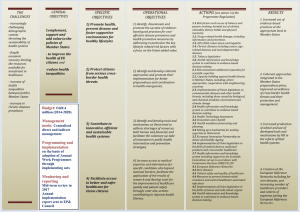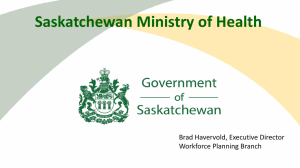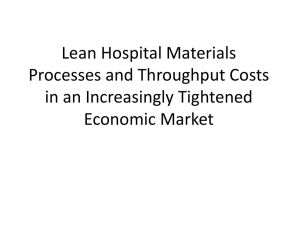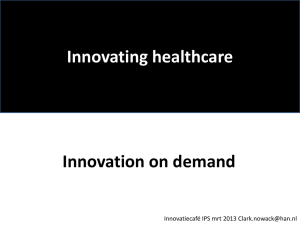Welcome to introduction to healthcare and public health in the
advertisement
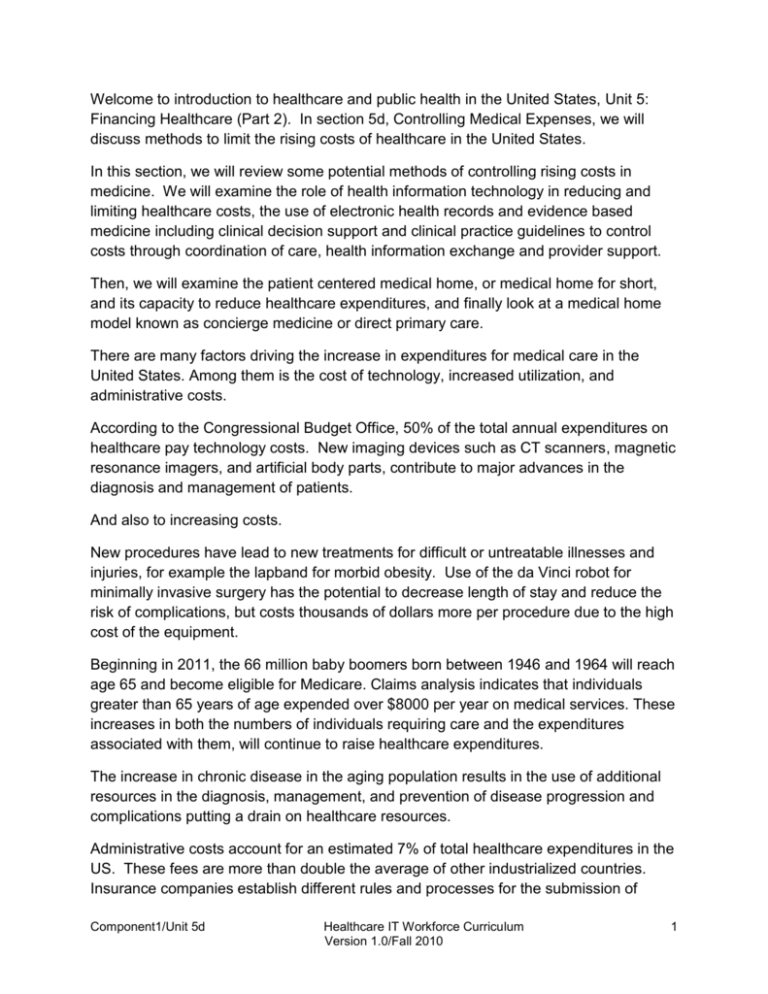
Welcome to introduction to healthcare and public health in the United States, Unit 5: Financing Healthcare (Part 2). In section 5d, Controlling Medical Expenses, we will discuss methods to limit the rising costs of healthcare in the United States. In this section, we will review some potential methods of controlling rising costs in medicine. We will examine the role of health information technology in reducing and limiting healthcare costs, the use of electronic health records and evidence based medicine including clinical decision support and clinical practice guidelines to control costs through coordination of care, health information exchange and provider support. Then, we will examine the patient centered medical home, or medical home for short, and its capacity to reduce healthcare expenditures, and finally look at a medical home model known as concierge medicine or direct primary care. There are many factors driving the increase in expenditures for medical care in the United States. Among them is the cost of technology, increased utilization, and administrative costs. According to the Congressional Budget Office, 50% of the total annual expenditures on healthcare pay technology costs. New imaging devices such as CT scanners, magnetic resonance imagers, and artificial body parts, contribute to major advances in the diagnosis and management of patients. And also to increasing costs. New procedures have lead to new treatments for difficult or untreatable illnesses and injuries, for example the lapband for morbid obesity. Use of the da Vinci robot for minimally invasive surgery has the potential to decrease length of stay and reduce the risk of complications, but costs thousands of dollars more per procedure due to the high cost of the equipment. Beginning in 2011, the 66 million baby boomers born between 1946 and 1964 will reach age 65 and become eligible for Medicare. Claims analysis indicates that individuals greater than 65 years of age expended over $8000 per year on medical services. These increases in both the numbers of individuals requiring care and the expenditures associated with them, will continue to raise healthcare expenditures. The increase in chronic disease in the aging population results in the use of additional resources in the diagnosis, management, and prevention of disease progression and complications putting a drain on healthcare resources. Administrative costs account for an estimated 7% of total healthcare expenditures in the US. These fees are more than double the average of other industrialized countries. Insurance companies establish different rules and processes for the submission of Component1/Unit 5d Healthcare IT Workforce Curriculum Version 1.0/Fall 2010 1 claims, and these processes require additional administrative costs by healthcare organizations to meet the specific requirements. Transparency, or lack thereof on the part of third party payers in the process of determining the value of healthcare services and reimbursements leads to variations on payments for the same service among different insurance companies, and in some cases within the same company. Insurance companies have traditionally looked to providers for discounts in order to cut costs. In a fee-for-service reimbursement scheme, physicians may alter their practice patterns leading to increased utilization of services to offset the lost income and pay practice expenses. This leads the need for additional staff and to a cycle of increasing utilization and administrative costs. Additional factors driving utilization include patient preference and defensive medicine. Demand for new technology can be driven through direct-to-consumer advertising about products and services that may imply additional health benefits through their adoption. This cost of new technology may not be justified by the marginal increase in value in the care and treatment of patients. However, providers may begin using it due to patient demand. Defensive medicine – the prescribing of diagnostic and/or therapeutic measures to avoid malpractice litigation – contributes to over-utilization of some services, for example expensive imaging studies. Tort reform and the use of clinical guidelines may help to lower costs in the future. We know why costs are going up. What methods can be used to increase access to care, improve quality, and control costs? Who becomes responsible for keeping costs under control – the patient, the physician, the hospital, the third-party payer, the employer? How does one determine the value of new technology in improving patient outcomes? How do we slow or avoid the development of chronic disease in an aging population? There is no easy answer to these questions. One potential cost control method includes limiting the available resources or rationing. Another method involves decreasing utilization patterns by increasing the patient share of the costs, or by investing in wellness and prevention. Both rationing and increasing the patient share of costs raises ethical questions about care for the disadvantaged, the potential for creating a two-tiered healthcare delivery system, and the appropriate utilization of services by untrained consumers. In addition, while wellness and prevention programs may result in less complications and longer Component1/Unit 5d Healthcare IT Workforce Curriculum Version 1.0/Fall 2010 2 periods of health, the additional consumption of health resources needed in wellness and prevention programs may offset any potential savings. Perhaps the best method of controlling costs is to increase the efficiency of healthcare delivery using health information technology, evidence-based medicine, and clinical practice guidelines. Health information technology or HIT, in conjunction with evidence-based medicine, offers an opportunity to slow healthcare expenditures. The Health Information Technology for Economic and Clinical Health Act or HITECH Act authorized the federal government to take the leadership role in developing standards to allow for the nationwide electronic exchange and use of health information to improve quality and coordination of care. It will provide savings through reduction of medical errors and duplicate care. The government will invest over $19 billion to reward healthcare organizations and providers who use electronic health records or EHRs in a meaningful way. An EHR facilitates the coordination of care and can support providers through the use of clinical decision support or CDS, based upon the clinical practice guidelines applicable in the particular clinical situation. Clinical decision support is the real time delivery of information that could aid in the diagnosis or management of the patient as the physician uses the electronic medical record. Physicians receive reminders that may help themmake appropriate decisions regarding the use of healthcare resources for the diagnosis and management of the patient. The use of CDS has the potential to lower costs by avoiding diagnostic expenses such as duplicate testing and/or procedures that have only a marginal value in aiding the decision-making process. It aids management of patients by avoiding errors, for example, prescribing a medication to which the patient has an allergy or which may adversely interact with another medication the patient is already taking. Real time decision making may avoid the additional expense associated with those errors. HIT further supports lowering costs through health information exchange by permitting access to records through the sharing of information among providers, and the potential to avoid duplication of procedures and services. Evidence-based medicine or EBM involves the review of published research studies in evaluating value of a treatment. Using the results or evidence of these reviews to design clinical practice guidelines, practitioners can treat patients based upon an established standard of care. This has the potential to lower costs since patients are treated according to a standard based on evidence of the effectiveness of a treatment. Component1/Unit 5d Healthcare IT Workforce Curriculum Version 1.0/Fall 2010 3 It also has the potential to stop the practice of defensive medicine by establishing a standard for care. Some physicians have criticized clinical practice guidelines as cookbook medicine, but the goal of clinical practice guidelines is to establish a benchmark from which a physician can initiate treatment under a particular set of circumstances. It does not prevent a physician from altering the treatment plan in the future based upon the results of the standard of care. Evidence-based medicine can be used to establish the value of new technology. For example, the additional cost of minimally invasive surgery using the da Vinci robot has been justified by the lower complication rate and length of stay, thus decreasing overall costs of care. By comparing the overall costs of minimally invasive surgery using the da Vinci system, including complications, against those of standard minimally invasive surgery, evidence can be gathered to support or disprove the cost savings assumption. Attempts to lower costs while maintaining access, comprehensiveness, and quality of care include an approach called the Patient Centered Medical Home or Medical Home for short. Early indicators suggest that it may result in lower costs. It could be considered a long-term approach to providing comprehensive evidence based primary care to meet the medical needs of patients. Services include care for acute and chronic illness, preventive care, lab and x-ray among others. The primary care physician directs medical services with the assistance of a team. This team may include nurse practitioners, physician assistants, nutritionists, pharmacists, social workers, and behavioral health specialists that takes collective responsibility for the patient’s medical needs. There is enhanced access to all care team members, which facilitates partnerships between patients and the providers. The team is responsible for coordinating care with other organizations such as home health providers or hospice, and making appropriate referrals to hospitals and specialists. Active patient participation in the decision making process empowers patients and their families. A care planning process using evidence-based medicine, clinical decision support tools, and quality performance measurements assures quality and safety. A 2004 study found overall medical expenses could be reduced by 5.6% resulting in huge savings using the medical home model. Concierge medicine is a medical home model also called direct primary care or retainer practice. The patient pays a monthly or annual retainer or membership fee and Component1/Unit 5d Healthcare IT Workforce Curriculum Version 1.0/Fall 2010 4 receives all care through the practice. In return, the patient receives special services and enhanced access to the provider. There are variations on the model. All of the models limit the number of patients in the practice, usually less than 500. Some may bill insurance an addition to the membership fee, but many do not. The plans are not a substitute for insurance, and patients should maintain private health insurance for catastrophic medical events. Typical features of the retainer practice are similar to the Medical Home. Appointments are available the same day for urgent medical issues and next day for non-urgent issues. The patient has the provider’s mobile or home number and access 24 hours a day. Patients receive the personal attention of the provider during extended office visits. Many insurance plans do not offer or limit the number or type of preventive services available. Most retainer practices offer a full range of preventive care physicals and screenings. When necessary and appropriate, patients receive house calls to home or workplace as required. Wellness and nutrition counseling are provided, along with mental health counseling and behavioral counseling for such issues as stress reduction and smoking cessation. In general, practice costs are lower primarily due to the limited number of patients in the practice. Since many concierge practices do not bill insurance, the administrative staff levels are lower. In addition, fewer nursing staff are needed to support the smaller volume of patients seen on any particular day. Overhead costs are lower as less office space is needed to accommodate the smaller number of patient appointments and administrative staff for billing, etc. This also results in lower utility costs. Quality of care is perceived to be higher by patients, but evidence suggest there is no difference in the quality of measured medical outcomes from a traditional primary care practice. According to a report in Health Affairs published in 2010, further study is needed to show if this model will have any effect on overall healthcare expenditures. Some employer groups are testing the model to see if it results in lower overall healthcare spending. Since patients must still maintain health insurance for extraordinary expenses not covered by the membership fee, there may not be any real cost savings. In addition, during the short term this model may exacerbate the shortage of primary care physicians as more providers move to the model, but it eventually may lead to more physicians becoming primary care specialists. Component1/Unit 5d Healthcare IT Workforce Curriculum Version 1.0/Fall 2010 5 Improved efficiency through the use of health information technology, evidence-based medicine, and clinical practice guidelines has the potential to produce the most saving. Evaluating new technology and incorporating the evidence of its effectiveness into clinical practice guidelines may lead to substantial savings in the future. New primary care models such as the Medical Home have shown reduction in costs and potential for savings, while the jury is still out on concierge medicine retainer models. Component1/Unit 5d Healthcare IT Workforce Curriculum Version 1.0/Fall 2010 6

